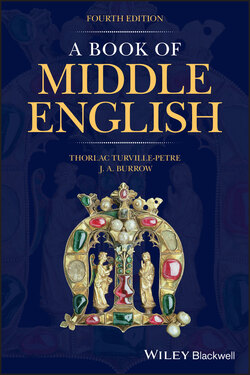Читать книгу A Book of Middle English - J. A. Burrow - Страница 47
4.5.2 Present Tense
ОглавлениеThe endings of the present tense are the same for weak and strong verbs, but there are considerable variations according to dialect. Differences may be illustrated by setting out the forms in the language of the Ancrene Wisse (early thirteenth century, South‐West Midlands) side by side with those in the language of the Gawain manuscript (late fourteenth century, North‐West Midlands), taking the verb here(n), ‘to hear’, as the example:
| Ancrene Wisse | Gawain | ||||
| infinitive | heren | here | |||
| indicative | |||||
| sg. | 1 | ich | here | I | here |
| 2 | þu | herest | þou | heres | |
| 3 | he | hereð | he | heres | |
| pl. | we, ʒe, ha | hereð | we, ʒe, þay | here(n), heres | |
| subjunctive | |||||
| sg. | ich, þu, he | here | I, þou, he | here | |
| pl. | we, ʒe, ha | heren | we, ʒe, þay | here(n) | |
| imperative | |||||
| sg. | her | her(e) | |||
| pl. | hereð | heres | |||
| present participle | herinde | herande |
Wherever it occurs, the ‐en ending is gradually lost, leaving ‐e or no ending. The result of this development, in some dialects, is that only the indicative second and third persons singular and the present participle have distinctive endings. In Northern texts the verb ending is generally lost when the plural pronoun immediately precedes the verb: we tyne, 15/300.
The dialectal variations, affecting chiefly the endings of the present indicative third person singular and the plural, and the present participle, are as follows:
Third person singular
1 ‐es is Northern and North Midland (in texts 8–11, and predominantly in 15, with a few ‐eth/‐ith forms; also in the speech of the Northern students in 18a).
2 ‐eth is Southern and South Midland (to the south of Cheshire, Derbyshire and Lincolnshire).
(In Southern dialects the ending ‐eth is reduced to ‐th, which is assimilated into a stem ending in d or t, so that he findeth becomes he fint, ‘he finds’ (5/239); similarly fyght, ‘fights’ (16/103), last, ‘lasts’, sit, ‘sits’, stant, ‘stands’, went (from wenden), ‘goes’.)
Plural
1 ‐eth is Southern and South‐West Midland (to the south of Shropshire, Warwickshire, Cambridge and Norfolk). It is the form in texts 2–5 and 12.
2 ‐e(n)/‐on is North‐West Midland, East Midland, and from there spread to London (in texts 1, 6, 8–11, 13, 16, 17 and 18).
3 ‐es is Northern (Lancashire, Yorkshire, Lincolnshire and further north), as in text 15 and occasionally 8–11; also in the speech of the Northern students in 18a.
Present participle
1 ‐ing is the general Southern and Midland form (in texts 5–7 and 12).
2 ‐ande is the Northern form, which is also found elsewhere, particularly around London (texts 8–11, 15, and twice in 5).
3 ‐inde is found in the South‐West Midlands (texts 2, 3 and 4).
4 ‐ende is used in the East (texts 1 and 13).
(Note that in many dialects the present participle, which is an adjective, is distinguishable from the verbal noun or gerund which ends in ‐ing in all dialects. Compare the participle in þe stif kyng hisselven / Talkkande, 9/107–8, with Dere dyn upon day, daunsyng on nyʒtes, 9/47, where daunsyng is a noun parallel to dyn.)
In Southern dialects, including the South‐West Midlands, some verbs have infinitives in ‐i(e)n or ‐i(e); e.g. makien, lokin, luvie. These descend from Old English Class 2 weak verbs, ending ‐ian (see Guide to Old English, §124). These verbs retain the ‐i‐ in all parts of the present except the second and third persons singular of the indicative and the imperative singular. Hence in Ancrene Wisse, makien, infinitive (4/13), makeð, third person singular (4/46), makieð, plural (4/3); in Piers Plowman, the infinitives wedy, ‘weed’, 7b/66, and gladyen, ‘gladden’, 7b/126. Some French and Scandinavian loans were conjugated according to this pattern; e.g. servið, ‘(they) serve’, 4/14, proferi (infinitive), ‘offer’, 5/434.
